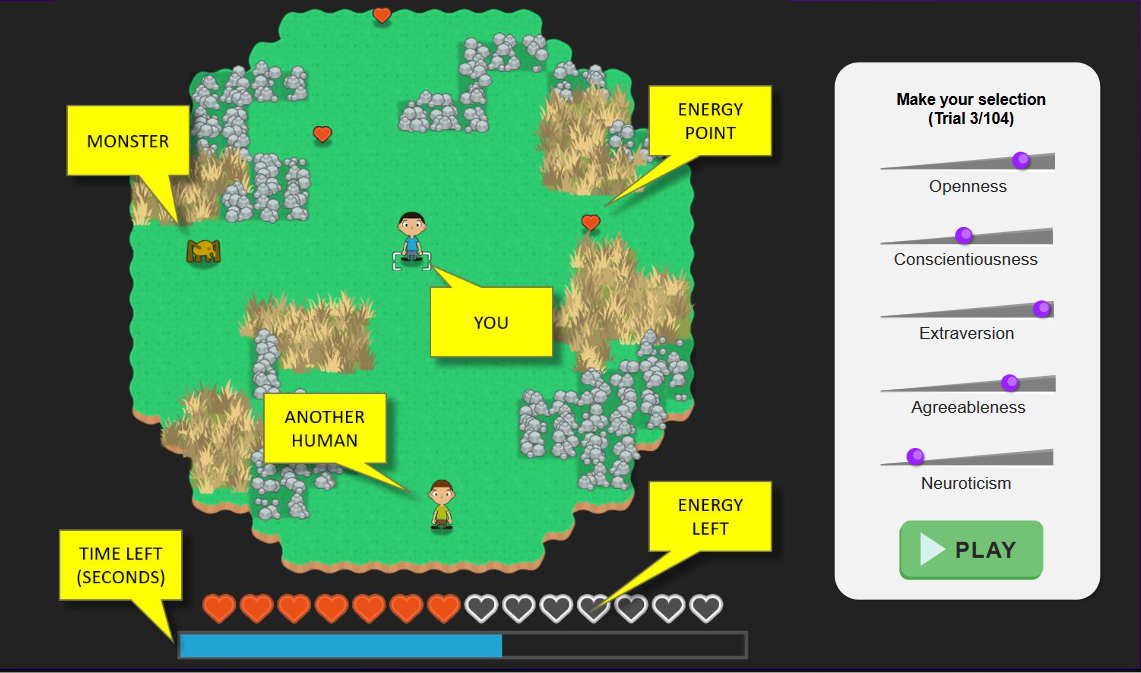Online Demo
Try to play the GAB5 right here! Before diving into the demo, we strongly recommend going through the brief gameplay instructions provided below.
Below is the link to start the online demo. You can download your own game responses (.CSV) at the end of the game, we are not saving nor using your data.
For actual research participants, the instructions are more comprehensive, involving interactive trials for better understanding of the game mechanics.
The demo involves approximately 10 with randomly generated maps. It uses GAB5 version 2.0 and thus involves some “kind” and “selfish” non-player-characters. Demo uses 7-point Likert scale.
Game Instructions
In the game, your character starts at the center of the screen. The primary objective is to ensure your character’s survival for as long as possible while accumulating maximum energy. Achieving these goals will contribute to your overall score.
The game consists of multiple rounds, approximately 30 in this demo, with each round lasting up to maximum of 20 seconds. To familiarize yourself with the game, the initial few rounds are repetitive, featuring the same map multiple times. (In the real study context, some trials are shown “blinded”, that is, without the animations.)
Surviving in the game isn’t always straightforward! You may encounter attacks from monsters scattered across the field or engage in skirmishes with other players. Additionally, your energy level gradually decreases over time, indicated by the heart bar at the bottom of the screen.
Screenshot of the game and the game elements is shown below.
It is important to note that you don’t have real-time control over your character! Instead, you must determine the most suitable personality to adopt at the beginning of each round. Use the five personality trait sliders to make these decisions.
Here are some examples of how the Big Five personality traits can influence your character’s actions:
- OPENNESS: A character with high openness reacts to and considers things that are far from themselves. They also actively explore their environment. A character with low openness focuses only on their immediate surroundings.
- CONSCIENTIOUSNESS: A character with high conscientiousness sticks to their decisions and goals. A character with low conscientiousness can be absent-minded but responds quickly to changing situations.
- EXTRAVERSION: A character with high extraversion approaches things that provide or can provide energy with enthusiasm. A character with low extraversion does not get excited about much and may prefer being alone.
- AGREEABLENESS: A character with high agreeableness willingly cooperates with others and acts kindly. A character with low agreeableness may attack others and act deceitfully in cooperative situations.
- NEUROTICISM: A character with high neuroticism is fearful, easily angered, and prone to fighting. A character with low neuroticism is calm, fearless, and unconcerned about dangers.
Within the game, you’ll find brief descriptions of the personality traits by clicking the question mark symbol.
Each round presents both optimal and suboptimal choices. It’s essential to look for best solution for each round, as a single strategy may not work for all rounds. Just like in real life, not all events can be controlled, and unexpected things can happen.
Go ahead and learn as you play the game!
Recorded Gameplay
Below is a recorded video of the game, featuring several rounds from the GAB5 Gameset v1.0 (refer to Materials for more information).


